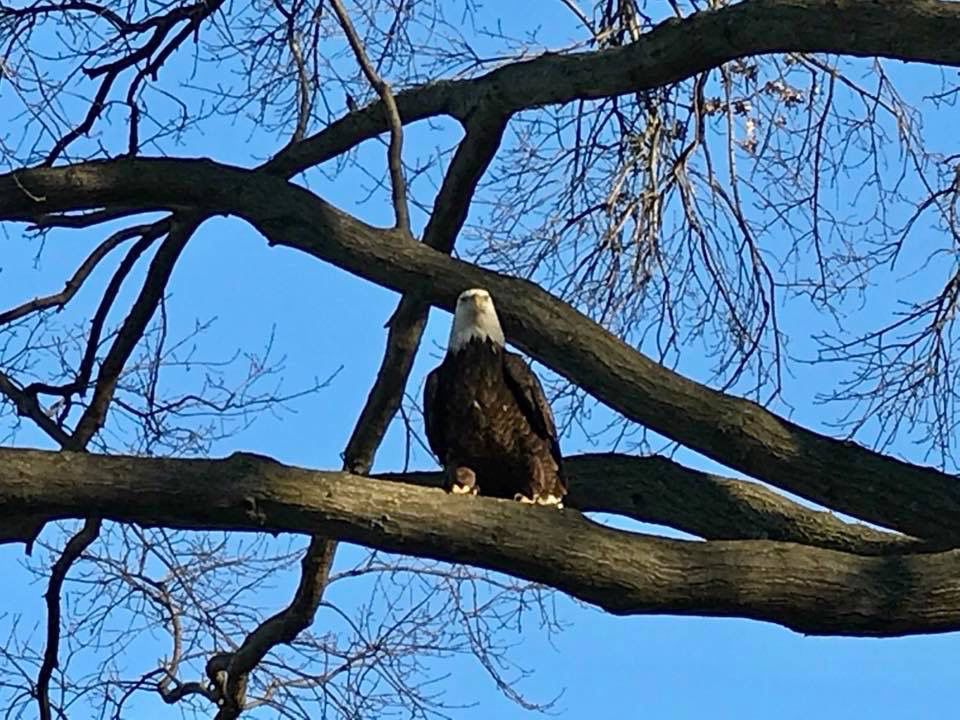Margaret Reist: Bald eagle visits Lincoln school, teddy bear science and plastic bags for homeless
This eagle has been hanging out in the trees and grounds near Morley Elementary School, 6800 Monterey Drive, since September.
Some years ago I was pretty taken with the wild turkeys making their way into my neighborhood, a little piece of the country sauntering across the street as I made my way to work.
Sorry, turkeys. You’ve been upstaged.
Since September, a bald eagle has been visiting Morley Elementary School, 6800 Monterey Drive — a school along South 70th Street in my end of town.
Principal Molly Bates said the majestic bird periodically shows up in the morning at the front of the school, which sits back from 70th Street, or in the trees near the school sign.
Kids, parents and teachers have seen the eagle and snapped some pictures, though Bates has yet to catch a glimpse. And the bird astutely generally stays clear when kids are on the playground.
The bird’s appearance, while unusual, follows a trend of eagles soaring into urban areas looking for food — similar to other wildlife, said Joel Jorgensen, the nongame bird program manager for the Nebraska Game and Parks Commission.
But Jorgensen said eagles can be spotted pretty regularly near 27th Street and Cornhusker Highway, looking for food along Salt Creek.
Luckily, I haven’t run into any coyotes or mountain lions in my neighborhood.
But the critters are coming to urban areas because they can find food, and animals such as eagles — once common in these parts before essentially being wiped out — are now federally protected.
Jorgensen said before 1991, there were no nesting bald eagles in the state. In 2017, there were more than 200.
He confirmed Bates’ suspicions that the Morley eagle is likely drawn to nearby Holmes Lake, rather than the school playground, though it’s also likely he’s found the grove of trees near the school sign a quiet roosting area.
Still, it’s hard not to want to claim him, especially since the Morley folks have had a thing for birds since they adopted the Meadowlark as their mascot when the school opened in 1961.
Teddy with purpose
Tucker Robinson, a fifth-grader at Heartland Community Schools in Henderson, got $15,000 for his school's science program by beating out 8,000-some contestants across the nation with an idea inspired by his uncle.

Tucker Robinson, fifth grader, Heartland Community School
He’s always been close to his mom’s brother — Tower Robinson, who was diagnosed with juvenile diabetes when he was 10.
“(Tucker's) been talking since first grade about finding a cure for juvenile diabetes,” said his mom, Sadie Coffey.
So when Coffey — who also happens to be the school’s principal — learned about a new “If Kids Could Cure” contest sponsored by Pfizer and Scholastic, she sent a notice to all the teachers.
Turns out lots of students were busy with other projects, so Tucker and his younger sister were the only ones to send in their ideas (see what happens when your mom is the principal?)
The contest required grade-school students to dream up solutions to medical or societal problems. It wasn't tough for Tucker to decide on a topic.
His idea: to create stuffed animals that can detect blood-sugar levels in kids and then provide them with next steps such as exercise or taking insulin, or what they should eat.
He also suggested a superhero television series to educate kids on juvenile diabetes, Coffey said.
Tucker won first prize in the third-through-fifth-grade category, while a student in New York won the K-2 category.
In addition to $15,000 for the school science program, his teacher got $200 for books from Scholastic, and Tucker got a backpack full of science supplies.
Tucker is most excited about the chance to talk with the Pzfier scientist who inspired the contest.
“He’s got a list of questions,” Coffey said.
Plastic bag innovation
I recently did a story about Pound Middle School students who have collected about 750 pounds of plastic bags for a company that makes decks and furniture out of the recycled material.
Turns out they’re not the only ones collecting the billowy plastic. Members of Shepherd of the Hills Church in Hickman also collect them, then crochet them into sleeping mats.
And they're looking for some help from area schools or after-school programs.
The church doesn't need help finding the bags so much as it does cutting them into strips, rolling the strips into balls and crocheting the mats.
The church distributes the mats to programs that serve the homeless, directly to those sleeping on the streets or to families with more people than beds.
Church member Sharon Johnson said the church has been making the mats for six or seven years — likely more than 150 of them.
It used to work with Nebraska Wesleyan University students and now coordinates with Lutheran Campus Center at the University of Nebraska-Lincoln to collect the bags.
But the work of turning the bags into "plarn" (get the play on words there?) and crocheting the mats is now being done by two women in their 80s, she said. And they could use a bit of help. Anyone interested should call the church at 402-792-2901.
Reach the writer at 402-473-7226 or mreist@journalstar.com.
On Twitter @LJSreist.







